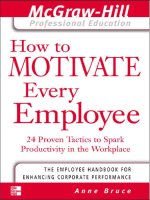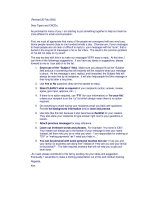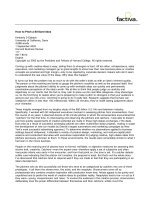Tài liệu How to write time saving email messages pptx
Bạn đang xem bản rút gọn của tài liệu. Xem và tải ngay bản đầy đủ của tài liệu tại đây (17.98 KB, 1 trang )
(Revised 20 Feb 2003)
Dear Tigers and CNCDs,
As promised to many of you, I am starting to put something together to help our team be
more efficient in email communication.
First, we must all appreciate that many of the people we correspond with are very busy.
Some people receive close to one hundred emails a day. Chances are, if your messages
to these people are not clear or difficult to reply to, your messages with be “sunk”, that is
buried in the long list of messages in his or her inbox. The result is the common problem
of “he did not reply to my email”.
The way we deal with this is to make our messages VERY easy to reply. At this time, I
can think of the followings suggestions. If you have any ideas or suggestions, please
forward to me so I can add on to the list:
1. Smart use of the “Subject” field. Make sure you always fill out the “Subject”
field and put in something that will instantly tell the recipient what your message
is about. As the message is sent, replied, and forwarded, the Subject field will
always be seen first by all recipients. It will also help people find this message in
their long list after a long time.
2. Use Yes or No questions (they are the easiest to reply).
3. State CLEARLY what is required of your recipients (action, answer, review,
agree, give input, approve, etc…)
4. If there is no action required. use “FYI” (for your information) or “for your file”,
unless your recipient is on the “cc” list which always mean there is no action
required.
5. Do everything to avoid having your recipients email you back with questions.
Provide full background information and be clear and precise.
6. Use lists (like this list) because it also becomes a checklist for your readers.
They also allow your recipients to type answer right next to your questions or
issues.
7. Attach previous messages for easy reference.
8. Leave out irrelevant words and phrases. For example: “my name is XXX”.
Your reader can always go to the bottom of your message to see your name.
Instead, tell them who you do or what you want: “I am responsible for ordering at
TDV” or “making payments” or “I need your help in…”
9. You can be personal with some personal touches but use “I trust you and
your family (or business) are doing fine” instead of “How are you and your family
(or business)?”. The later requires answers that will not help you to get your
work done.
As I said, please contribute to this list by sending me your ideas and suggestion.
Eventually, I would like to make a training presentation out of this and conduct training.
Regards,
Ken









